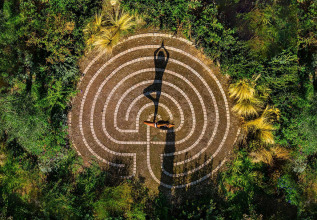4 MIN
TRAVEL TIPS
Bookbinding in Athens

My small world revolves around books. Books carry on their fragile pages the thoughts on mankind. And since it has been said "I think therefore I am" one can say that books are arks of existence. And how do you make such an ark? Simple- by binding a book... Almost all civilizations have created something that could be qualified as "book". Clay tablets linked together, bamboo strips forming a continuum, papyrus scrolls, etc. The common form we take as granted today was an ergonomic innovation that gradually won the competition. The first reports of such books date back to the ancient Romans. But a book that can traverse centuries with its precious content always available is not an easy thing to produce. It must be resilient, functional and aesthetically pleasing. The procedure involves some 40 different stages, in some cases even more. At first there's only a number of loose folios with the content of the -yet to be- book printed on them. Then the folios are folded, placed in front of cord strands held tight on a frame and sewn to each other in a single body. Now you have something that is compact, readable and can be carried around. Yet it is still fragile, awkward to use and difficult to store properly.
After the book is sewn its spine is rounded and lined with mull and paper. A properly rounded spine offers a spring-like action that facilitates the opening and closing of the book thus ensuring its longevity. Then cover boards are attached on the book block. The boards were traditionally made from wood and later by sturdy cardboard which is laminated to minimize warping. The whole structure is then enveloped in some covering material. Almost everything has been used as a covering material for books but leather is the indisputable winner. Calfskin, goatskin, sheepskin, fishskin, reptile skin, bird skin, even human skin (yuck!), you name it! Then the binding is decorated and there is a myriad of ways and techniques to do so. The most common form is by heating brass tools and when they are at just the right temperature (which can't be measured and is only recognized through experience) they are pressed on the leather to leave an impression. It can be anything, from a single line to an elaborate floral ornament. Using gold leaf the tooled motifs acquire the recognizable classic appearance. However a classic style is only one of the ways to go when it comes to bindings. A binder may get all creative with the decoration of his/her binding, or even its form, thus producing a "design binding".
The 20th century with its variety of art motions took the craft of bookbinding on a roller-coaster of moods, forms and ideas. But bookbinding is rather an amalgam of various crafts and professions than a single one; Leatherworking, sewing, gilding, goldsmithing, sculpturing, painting, restoration, etc. Greece has played in the past a crucial role in the history of books, with its peak during the prime of the eastern Roman empire centered at Byzantium.
You can still get a glimpse of a time where books were among the most treasured possessions by visiting monasteries across Greece, especially at Meteora and Mount Athos. Many of these grant supervised access in their libraries where codices have been kept for eons. The monastery of Patmos is renown for its precious collection. Last but not least the Byzantine museum in Athens has a number of codices on display.
Text by Dimitris
Dimitri's bookbinding corner


